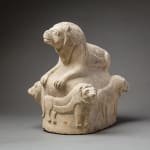Achaemenid Stone Sculpture of Lions, 500 BCE - 400 BCE
Stone
29.2 x 26.7 cm
11 1/2 x 10 1/2 in
11 1/2 x 10 1/2 in
FF.049
Further images
The Achaemenid Empire (559 -330 BC) was one of the most dynamic and historically significant socio-political entities of the first millennium BC. Originally based in Persia, their borders extended eastwards...
The Achaemenid Empire (559 -330 BC) was one of the most dynamic and historically significant socio-political entities of the first millennium BC. Originally based in Persia, their borders extended eastwards and also into the Mediterranean region, where they were the notable foe of the ancient Greeks. The founder (the mythological founder of the Achaemenid empire was called Achaemenes) Cyrus, following an abortive raid on the Peloponnese, besieged and captured Babylon in 539 BC; his release of Jews who had been held captive there earned him immortality in the Book of Isaiah. The empire continued to grow until Cyrus’ death in 529 BC, by which time the kingdom extended as far as the Hindu Kush in present-day Afghanistan. However, his successors were less successful and the empire was gradually eroded as intrigue and corruption threatened court stability. Darius, beaten at the battle of Marathon in 490 BC, led the Achaemenids back to Asia Minor where they attempted to consolidate the remains of their power. While successful in his lifetime, the court and empire returned to their usual downward cycle until the death in 330 of the last of the Achaemenids, Darius III, at the hands of his own subjects.
The cultural achievements of the Achaemenids were considerable, for although somewhat despotic in the technical sense, free trade and social tolerance went to provide a comparatively enlightened environment in which the arts flourished. The economy was healthy, fuelled by Darius’ introduction of stable gold currency, and the road system allowed the spread of trade, luxury items and ideas. As a result the artists and craftsmen of the time were extremely attuned to neighbouring and distant polities, and were able to produce a wide variety of elite items such as this. Most iconography of the time was based around enormously ornate zoomorphic statuary and architectural design as seen in Persepolis, and smaller items retain much of their grandiose monumentality.
The cultural achievements of the Achaemenids were considerable, for although somewhat despotic in the technical sense, free trade and social tolerance went to provide a comparatively enlightened environment in which the arts flourished. The economy was healthy, fuelled by Darius’ introduction of stable gold currency, and the road system allowed the spread of trade, luxury items and ideas. As a result the artists and craftsmen of the time were extremely attuned to neighbouring and distant polities, and were able to produce a wide variety of elite items such as this. Most iconography of the time was based around enormously ornate zoomorphic statuary and architectural design as seen in Persepolis, and smaller items retain much of their grandiose monumentality.







